An Tir Internal Letter for September, AS XXXX / 2005 CE
 |
Lady Richenda du Jardin, Lions Blood Herald |
- LETTERS FROM KINGDOM HERALDIC STAFF
- HERALDIC ARTICLES
- LAUREL ACTIONS
- LIONS BLOOD ACTIONS
- NEW SUBMISSIONS
Unto Christopher Black Lion and the esteemed members of the An Tir College of Heralds to whom this missive comes, Richenda du Jardin, Lions Blood Herald, sends greetings and felicitations.
COMMENTARY ON THE ITEMS IN THIS INTERNAL LETTER IS DUE ON THE 10TH OF NOVEMBER.
CHANGE OF MEETING LOCATION!!!!!The September Lions Blood meeting will be held Sunday, September 18, at Border War instead of my house. Directions are available from the event web site.
The October Lions Blood will be held at my house. I have newer and easier directions (now that the construction season is dying down). Directions:
From the West: Take your best route to I-90. Get off on exit 280 (Lincoln Ave/Maple Ave.). Turn left at Lincoln (the second light). Go one block and turn right (Third). Follow directions from **.
From the East: Take your best route to I-90. Get off on exit 280 (Lincoln Ave/Maple Ave.). Turn right at Third (the light).
** Turn right at the second light (Wall). Follow Wall until it ends at a T. Turn left onto Sixth. At the next intersection, turn right onto Howard. Find whatever parking you can as parking is rather tight. Walk up to 7th and I am in the brick building on the left (524 W 7th.). Buzz apartment #510 and someone will be down to get you.
Limited crash space will be available.
LETTERS FROM KINGDOM HERALDIC STAFF
From Black Lion
Black Lion is out of town on business this month.
From Lions Blood
Greetings this fine month of September. Tourney season is nearly over and we may rest our voices. But don't rest your books quite yet! Now is just the time to encourage people to submit! If they submit now, they should have the decisions on their devices and badges by next tourney season.
Just a few notes about the submissions I've been receiving:
- Please have your submitters send their submissions via regular postal mail, not certified or registered mail. I work during the day and must leave my office to get anything other than regular post. If your submitter must have confirmation that I've gotten their submission, the post office suggests sending the letter via delivery confirmation. I, myself, recommend following up with an e-mail.
- Please make sure your submitters understand that we need three copies of all forms and documentation. I have had to contact several submitters in the last month to let them know I needed more forms. This is a matter of customer service — lack of the right number of forms is a cause for return. Administrative returns provide lots of grist for the “heralds hate me” stories we've all heard!
- Please explain to your submitters that they need to send a $12 payment for each action. When a name and device are submitted together, it is two actions. I do not need a separate check for each item, just $12 for each item (one check for all items submitted is fine).
In addition, I need more commenters if I am to keep sending out hard copy of the Herald's Page. Later in this letter is a discussion, kindly written by Siren (Juliana de Luna), providing lots of ideas on how to do names commentary without a huge library.
HERALDIC ARTICLES
Period Forms of Address
By Lord Christopher Thomas, Black Lion Principal Herald
Hail An Tir!
This is the beginning of a small series of articles that come out of this year's Known World Heraldic and Scribal Symposium. This month I will be writing about something near and dear to many of us: Titles. In the interest of saving space in the Crier I will make this brief. Please forgive me for not going into too much detail here. I will be quite happy to discuss this with anyone who has questions.
First, on the subject of using more than one title before the name - “Duke Sir”, “Baron Master”, “Lord Baron”, etc. This practice, called title stacking, is very modern. More correct period title usage is to announce people by their highest or preferred title but not by multiple titles. “Duke Hammerhand Hitshard” not “Duke Sir Hammerhand Hitshard”, “Master Askme Illdoit” not “Baron Master Askme Illdoit”.
On the flip side it is quite acceptable, even encouraged, to add additional information after the name: “Duke Hammerhand Hitshard, Member of the Chivalry, Master of the Laurel, Holder of the Iron Chain, Baron of the Court of An Tir”. For an even fancier, more formal sound you can use honorifics such as “His Grace Sir Hammerhand Hitshard, Duke of An Tir, Master of the Laurel, Holder of the Iron Chain, Baron of the Court of An Tir.” All of these flourishes add a very nice touch and feel to formal introductions.
For less formal introductions or where repeating a name frequently (for example, in the second or later rounds of a tourney before the final round) you can use the shorter, quicker single title and name, “Duke Hammerhand Hitshard” or “Lord Letme Squashmbad.” You should announce title and honors for people when announcing combatants in the first and final round of a tourney or on formal occasions.
When using honorifics please be careful to be sure they are appropriate. For example, Royal Peers and landed Barons and Baronesses are Excellencies (we extend the courtesy honorific to Court Barons and Baronesses as well) but non-royal Peers (Knights, Laurels, and Pelicans) are not.
“Honorable Lord/Lady” is reported to have only been found in use in written form. “Lordship/Ladyship” are a referent (object) form. The direct form of address would still be “Lord/Lady.”
Thus, spoken form:
“Good morning, my Lady.”
“May I present His Lordship,
Viking Vikingsson.”
“Her Excellency, Baroness
Esmeralda of Thisland, has business before this Court.”
In written form of address:
“Unto the Honorable Lord John on the Tuesday before Michaelmas...”
In a similar vein, sergeant, squire, protégé, and apprentice are not titles. Corpora specifically prohibits their use that way. It is not appropriate to use them before a name. If announcing that someone is a squire/protégé/apprentice or sergeant/courtier/yeoman/gallant you should say who they are in fealty to. “Cannonfodder Macclesson, squire to Duke Hammerhand” not “squire Cannonfodder Macclesson”. “Lord Froderich Ironhand, sergeant to Baroness Esmeralda of Thisland” not “sergeant Froderich Ironhand.”
In addition to them not being titles a potentially even more important problem is that it is insulting to the person they are in fealty to. How can anyone know to tell His Grace Duke Hammerhand of the deeds of courtesy his squire has performed if they don't know who Cannonfodder is squired to? Why is Cannonfodder hiding his association with Duke Hammerhand?
While we're talking about announcing names on the tourney field I would like to take a moment to discuss fighting titles. This long-standing tradition, true. However, like all traditions it should be reexamined periodically. What exactly is a fighting title? Is a Grant of Arms for years of being a marshal and list mistress a fighting title? What about an AoA that was given in part for growth on the field? No one at the symposium seemed to be able to come up with a good definition or a good reason to limit field calls to strictly fighting titles. We don't limit A&S displays to strictly “A&S titles”, why do so on the field?
I am asking all members of the An Tir College of Heralds to give everyone their due and use the title they have earned. If someone has an award that confers a title then call them by that title (but only one of them) unless the holder asks you not to. It does not matter if they are Master Footsbane because they are a Master of Arms or a member of the Order of the Pelican or Laurel. A title comes from an award conferred by Their Majesties or by being a Royal Peer. We should recognize this fact.
I will stop here for this month though there is much more to say.
In Service to Kingdom and College,
Lord Christopher Thomas,
Black Lion Principal Herald
“But I don't have any books!” Commenting without Sources
by Juliana de Luna
Many of you doubtless feel that you don't have anything useful to say about the new Letter of Intent, because you don't have a great library and you aren't really comfortable with conflict checking. But there are still a lot of useful things that you can do. And many of them don't require any heraldic knowledge at all.
-
When the name is in submission, or already registered, check that names are spelled correctly - Believe it or not, submitters sometimes don't spell their own names correctly. Sometimes, their name was changed and they haven't yet been informed; sometimes, they just forget the spelling they submitted. You can check them in two ways:
- Go to a copy of the Ordinary and Armorial, like that at http://oanda.sca.org/ and click on Name Pattern Search Form.
- Go to a search engine like Google, and search on the name and “site:http://www.sca.org” or “site:http://www.antirheralds.org”
- Check that online documentation says what the submitter says it does. A recent submission was documented from an Academy of Saint Gabriel April Fools letter, which discusses names for a “Scottish-Gaelic Klingon” (no really, check it out at http://www.panix.com/~gabriel/membersguide/apr1998.html). Only one commenter noticed.
-
Read over each submission and its documentation to fill in any holes. Even if you can't provide
the information, pointing out something that's missing is helpful. What are some common things
that are missing?
- URL's for online documentation
- dates of registration for items
- evidence that someone has the right to a restricted charge (i.e., the date of a knighting, county, etc.) - these are found in the kingdom Order of Precedence
- tinctures in blazons
- Point out things that you don't understand. If you don't understand it, the explanation probably needs to be rewritten, at least to explain it to the submitter.
After you get comfortable with those things, there are more things that you can do. Some of them include:
-
Look up supporting data for name documentation. The main sources for good articles to do this
are:
http://www.s-gabriel.org/names/ The Medieval Names Archive
http://www.s-gabriel.org The Academy of Saint Gabriel (which has a search form for old letters)
http://www.sca.org/heraldry/laurel/names.html Names Articles on the Laurel Home Page - Check for style problems. Some basic style rules are pretty easy to apply. Last month's Herald's Page had a brief style checklist. Once you are comfortable with it, you can also use the “Argent Snail's Armory Insta-Boing Check List” at http://www.sca.org/heraldry/laurel/boing.html. Other articles discussing armory style can be found at http://www.sca.org/heraldry/laurel/education.html. Try them; that's how you learn.
- Try your hand at conflict checking - A basic guide can be found at http://www.antirheralds.org/education/basic_conflict_checking.html. Take a look, and give it a try. There are many copies of the O&A (Ordinary and Armorial) online; a list of links can be found at http://www.sca.org/heraldry/OandA/index.html. Make sure you explain why you think two items are in conflict. Don't worry if you get it wrong - it takes time to get good at conflict checking. One way to keep getting better is to check out Lions Blood decisions to see if she agreed with you.
LAUREL ACTIONS
There have been no LoARs published since the last letter.
LIONS BLOOD ACTIONS
These items will be forwarded to Laurel
-
Adam Fairamay — Device, New
Gyronny argent and vert, in bend a mallet bendwise sinister and a chisel bendwise sinister Or -
Aleksii Konstantinovich Chernyi — Name, New
Submitted as Aleksii Konstantinovich Chernoi, we changed the name in kingdom to Aleksii Konstantinovich Chernyi because we couldn't find any documentation of Chernoi as the form used in a surname.
Chernoi can be found in Paul Wickenden of Thanet's “Dictionary of Period Russian Names” on the Laurel website (http://www.sca.org/heraldry/paul/a.html) under the heading <Chernoi>, dated to 1498. This listing provides several bynames based on the given name, including <Crnyi> (1280), <Chernyi> (1393) and <Tsernyi> are all found as bynames under the heading Chernoi. We changed the byname to <Chernyi> as it seemed closest to the submitted form.
The first byname citation under <Chernoi> follows exactly the submitted format: <Fedor Rostislavich Crnyi>. Wickenden tends to only provide the first citations of a name he finds, so we don't see any temporal problem with this name. -
Arianwen Prydydd — Name, New
Prydydd can be found in the Compleat Anachronist, issue entitled “A Welsh Miscellany” by Tangwystyl verch Morgant Glasvryn. It can also be found in T.J. Morgan & Prys Morgan, Welsh Surnames. Siren questions whether or not the name should be mutated, possibly to <Brydydd>, similar to the changes that occur when Irish names are lenited. -
Eibhlin nic Domnaill — Name, Change of Holding Name
Eileen of Dragon's Laire
ingen Domnaill is documented from St. Gabriel letter 2702 (http://www.s-gabriel.org/2702). St. Gabriel cites Sharon Krossa's “A Simple Guide to Constructing 12th Century Scottish Gaelic Names” (http://www.MedievalScotland.org/scotnames/simplescotgaelicnames12.shtml) and George F. Black, The Surnames of Scotland, (s.n. Donald). St. Gabriel asserts that Domnall was used in Scotland in the 12th century and that the genitive form is Domnaill. There was a minor problem with the name's grammar, but, per a phone call with submitter, she will accept grammar changes for post-1200 form of name. As the submitter asked for a post-1200 form of the name, Siren believes that would be <inghean Domhnaill>. -
Harald Warwicker — Name and Device, New
Azure, on a cross argent between four arrows in saltire points to center Or, a drawknife sable
Warwicker can be found in P.H. Reaney and R. M. Wilson, A Dictionary of English Surnames, s.n. Warwicker. Reaney and Wilson assert that Warwicker is a variant of Warricker and influenced by Warwick; however, no dated form was provided. Warwicker means maker of warrocks (scaffolds). P.H. Reaney and R. M. Wilson, A Dictionary of English Surnames, s.n. Warwick date Warwick to 1086 (Turchil de Waruuic) and 1196 (Richard de Warewic). They also date Warrock (s.n. Warrick) to 1271.
While the An Tir CoH was unable to find dated forms of Warwicker, we were able to find a few names that occur in both the object form and the object form +er (such as Wardrobe and Wardroper). We were unsure if this pattern would apply to this name and asked the College of Arms for help.
Drawknives are attested in period to the 13th century according to Gary R. Halstead on page 18 of his European Woodworking 600-1600 C.E. issue of the Creative Anachronist (Autumn 2003). In addition, there is one registered drawknife (Peter Sebastian Wyrhta, October 1988). -
Lars ís Björn — Name and Device, New
Argent semy of estoiles, on a base azure a bear passant contourny argent
Li Bann found Lars used as a given name in the lists of Swedish settlers from an article linked to the Medieval Names Archive entitled “New Sweden Settlers, 1638-1664”, by Dr. Peter Stebbins Craig (http://www.genealogia.fi/emi/3d41indexe.htm). The Medieval Names Archive makes the following note about the source:A bit later than our period, but otherwise excellent. The list of several hundred names includes men and women, Swedes and Finns.
We were unable to find any documentation of Isbjörn as a period byname or word meaning polar bear. The closest Siren was able to find was hvíta-björn in Zoega's Concise Dictionary of Old Icelandic. Zoega cites that this is the old Norse word for polar bear. Cleasby and Vigfusson's An Icelandic-English Dictionary concurs. In a telephone conversation with the submitter, the submitter indicated that if Isbjörn is not registerable, he would accept hvíta-björn.
We believe that this base line is not unreasonable given that the base is charged and the primary charge is a semy. We are asking the submitter to draw the bear a little smaller and the line of the base a little lower. -
Margit von Kreuznach — Name and Device, New
Argent, a fess counter compony azure and Or between two crosses formy and a lozenge sable
The submitter will accept any changes, does not care what must be changed, desires a female name, does not want name changed to be authentic, and will accept a holding name.
von Kreuznach is documented from a web site about Stadt-bad-Kreuznach (http://www.stadt-bad-kreuznach.de/stadtportrait/stadtgeschichte.htm). However, this web site did not provide period spelling of the city name. Brechenmacher, Etmologisches Wuurterbuch der Deutschen Familiennamen, (s.n. Kreuznacher) dates <Conr. Cruzenechir> to 1377, suggesting <von Cruzenech>.
The An Tir CoH is concerned with the potential issue of presumption with this name and device combination. According to the submitter's web site documentation, the arms of the city of Kreuznach are Argent, a fess countercompony Or and azure, three crosses sable. There is 1 CD for the change of the bottommost of three secondary charges. Precedent is very clear when a submitter wants to use arms that are too close to the family arms of the surname they choose. No one was able to find a precedent which applies when a submitter chooses arms that are too close to the corporate identity they are using as a surname (in this case von Creuznach/Kreuznach). Therefore the College left that determination up to Laurel. -
Mateusz z Plocka — Device, New
Counter-ermine, a bucket Or -
Owyne of Clan Frog — Device, Resubmission
Per pale sable and gules, an escarbuncle and on a chief enarched argent, two frogs tergiant respectant vert -
Swan the Red — Device, Change
Or a swan naiant contourny within a bordure gules
If this is accepted, the submitter wants to release his old device, Argent, a swan naiant contourny gules and a bordure sable. -
Winefred Dyghere of the Wode — Name, New
Dyghere can be found in Reaney & Wilson, A Dictionary of English Surnames, s.n. Dyer, where Alexander Dyghere is dated to 1296. <Gilbert le Dyghere> is found dated to the 1340s in “Misc. Roll DD - 5 Nov 1339 - 15 Dec 1346 (nos 349-399)” http://british.history.ac.uk/report.asp?compid=35976. Reaney & Wilson (s.n. Wood) dates <Alexandre of the Wode> to 1285. Dyghere is also found in entitled “Index to the Kent Lay Subsidy Roll of 1334/5”, by H.A.Hanley, B.A. and C.W. Chalklin, M.A., B.Litt at http://www.kentarchaeology.org.uk/Research/Pub/KRV/18/7/315.htm - Dyghere, Rd. le, 86.
of the Wode can be found in Reaney & Wilson, s.n. Wood, where Alexander of the Wode is dated to 1285.
These items are being returned for further work
-
Aleksii Konstantinovich Chernyi — Device, New
Lozengy sable and gules, a bear rampant maintaining a spear argent enflamed within a bordure Or
The original blazon incorrectly identified all charges as Or. This is the correct blazon based on the emblazon.
Unfortunately, this device violates RfS VIII.2.b.iv:iv. Elements evenly divided into multiple parts of two different tinctures must have good contrast between their parts.
For example, checky argent and gules is acceptable, but checky azure and gules is not.
Lozengy, like checky, evenly divides the field into multiple parts of two different tinctures. Gules and sable do not have good contrast between them; gules and Or, gules and argent, sable and Or, or sable and argent would have good contrast. The lozenges would be easier to see if they were fewer (five to eight horizontally and five or eight vertically) and thus a little larger.
In addition, the spear is not enflame; the head of the spear is fimbriated of a flame. CoH members at the meeting were unable to identify what the charge was without the blazon. This violates RfS VIII.3 Armorial Identifiability:Identifiable elements may be rendered unidentifiable by significant reduction in size, marginal contrast, excessive counterchanging, voiding, or fimbriation, or by being obscured by other elements of the design. For instance, a complex line of partition could be difficult to recognize between two parts of the field that do not have good contrast if most of the line is also covered by charges. A complex divided field could obscure the identity of charges counterchanged. Voiding and fimbriation may only be used with simple geometric charges placed in the center of the design.
The spear would be much easier to identify without the flames. On resubmission, the bordure should be drawn about twice as thick as it is in this submission. -
Sigelhundas, Shire of — Badge Resubmission
Azure, on a sun or a talbot's head erased affronty azure
This badge conflicts with the following registered armory:- Wendryn Townsend, January 1973, Azure, a sun in glory Or. There is one CD granted for the addition of the tertiary talbot's head per RfS X.4.i.
- Leith Ambránid, March 2002, Azure, a sun Or eclipsed azure and in base a triquetra inverted argent. There is one CD granted for the removal of the secondary charge. There are no CDs for the change of the tertiary charge. Per precedent, eclipsed suns can be reblazoned on a sun, a roundel; therefore, the eclipsing is treated as a tertiary for the purpose of conflict-checking. Because a sun is not a simple enough charge to be voided, two changes to the tertiary are necessary to qualify for a CD per X.4.j.i. There is only one change to the tertiary (from a roundel to a talbot head).
-
Tatiana of the Swans, May of 1993, Azure, on a sun Or, a mullet of
four points purpure charged with a swan naiant argent. There is one CD granted for
the change of tertiary from a mullet of 4 points purpure to a talbot's head azure as per
RfS X.4.j.i. However the
swan is a quaternary charge (a charge on a charge on a charge — four layers) and therefore
does not count for conflict per Mistress Shauna of Carrick's Point:
[Sable, on a compass star argent a Maltese cross azure and in base two swords inverted crossed at the tips argent] The device conflicts with Conner McAuliffe FitzJames, Sable, within a sun throughout argent, eclipsed azure, a goshawk displayed argent, which could also be blazoned as Sable, on a sun throughout argent, a roundel azure charged with a goshawk displayed argent. This emphasizes the quaternary nature of Conner's goshawk, and we ignore quaternary charges completely when checking for conflict. We give no CD between a compass star and a sun, nor for throughout vs. not-throughout for non-ordinaries. Since compass stars are not eligible for X.4.j.ii, there is no CD for type only between a roundel and a Maltese cross. Thus there is only one CD between this armory and Conner's for adding the secondary swords. [John the Wanderer, 05/04, R-Caid]
- Western Keep, Shire of, January 1994, Azure, on a sun within a laurel wreath Or a tower azure. There is one CD granted for the removal of the secondary laurel wreath as per RfS X.4.b. Because a sun is not a simple enough charge to be voided, two changes to the tertiary are necessary to qualify for a CD per X.4.j.i. There is only one change to the tertiary (from a tower to a talbot head).
- Stefan of Seawood, January 1973, Azure, upon a sun Or an eagle displayed sable. Because a sun is not a simple enough charge to be voided, two changes to the tertiary are necessary to qualify for a CD per X.4.j.i. There are two changes to the tertiary charge (from an eagle to an talbot head and from sable to azure) granting a single CD. Cumulative changes to single tertiary charge group can only provide a single CD per RfS X.4.j. Therefore there is only one CD for changes to the tertiary.
- Barre FitzRobert of York, April 1996, (Fieldless) On a sun Or a horned owl perched atop a spear azure. There is clearly one CD for the addition of the field. A quick review of Laurel's decision in this case indicated that this badge had a letter of permission to conflict with Laurelen Darksbane, Azure vêtu ployé sable fimbriated, on a compass-star Or an annulet azure. The only way for Barre's armory to have been in conflict was for the spear to be a maintained charge. If it were a sustained spear, the tertiary charge group would have had the requisite two changes to gain a second CD. Therefore, there is only one change from Barre's device to the submitted badge and they are in conflict.
- Laurelen Darksbane, October 1982, Azure vêtu ployé sable fimbriated, on a compass-star Or an annulet azure. There is one CD for the change to the field. Because a sun is not a simple enough charge to be voided, two changes to the tertiary are necessary to qualify for a CD per X.4.j.i. There is only one change to the tertiary (from an annulet to a talbot head).
NEW SUBMISSIONS
To be ruled on at the November Lions Blood Meeting.
| 1. Abrahe çaragoça de girona, from Ealdred Galt Mac an Toisich | Blatha an Oir | Name & Device — Change - New |
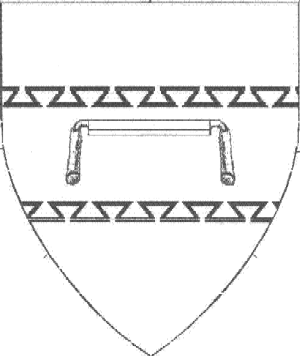 |
Or, on a Fess dovetailed Gules, a drawknife Or. The submitter will accept any changes necessary to register his name. If changes are required, he is more interested in the language/culture. He desires a male name, and is interested in a name authentic for the language, culture and time period “Early 16th Century Catalan Jew Converso.” He permits creation of a holding name.
Abrahe is a Jewish/Catalan given name which is a variant of Abraham. This is
found at
http://www.s-gabriel/names/juliana/catalan-jews/CatalanJews-given-men.html#alpha
No copies of this documentation is provided. Other apparent extracts of various websites are provided for Çaragoça including http://www.georgetown.edu/labyrinth/professional/pubs/ sala/handlist.html, which lists a Jacobus Çaragoça Girona is documented as a city 52 miles northeast of Barcelona, and is documented from http://libro.uca.edu/lewis/sfc3.htm, http://libro.uca.edu/lea1/1lea5.htm, http://campus.northpark.edu/history/WebChron/WestEurope/CharlesSpain.CP.html [Note: URL is incorrect; correct one is http://campus.northpark.edu/history/WebChron/WestEurope/CharleSpain.html - Online IL Ed.], http://isfsp.org/sages/girona.html, and http://girona.biography.ms/. The ISFSP web site indicates that there were Jews in Gerona in by 888 and as late as 1150. The Girona web site indicates that Girona is the Catalan spelling of the Spanish city Gerona. If this name change is registered, he wishes to retain his current name as an alternate name. If this device change is registered, he wishes to retain his current arms, Sable, an abacus bendwise Or within a bordure argent, as a badge. | |
| 2. Aquaterra, Barony of, for Order of the Blue Stag | Order name - New | |
|
The submitter will accept any changes to the name, does not express a preference if changes must be made, does not express a preference for an authentic name, and will accept a holding name. The Barony's name was registered in March 1983. Other than a quote of RfS III.2.b.ii (Names of Orders and Awards), no documentation for this submission is provided. The submitter indicates that “this is the second level Arts and Sciences Award.” Query for Gorges Pursuivant: Is it the intent of the Barony that the badge blazoned as Argent, a stag lodged contourny azure attired Or and a bordure nebuly azure (registered October 2003) be associated with this name if it is registered? | ||
| 3. Aquaterra, Barony of, for Order of the Boar | Order name & Badge- New | |
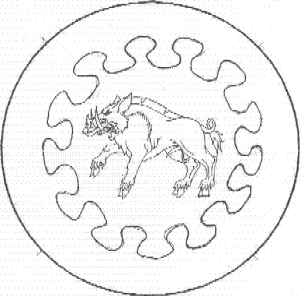 |
Argent, a boar passant within a bordure nebuly gules. The submitter will accept any changes to the name, does not express a preference if changes must be made, does not express a preference for an authentic name, and will accept a holding name. The Barony's name was registered in March 1983. Other than a quote of RfS III.2.b.ii (Names of Orders and Awards), no documentation for this submission is provided. The submitter indicates that “this is to be a children's chivalry award.” Boar Herald recommends consideration of the registered heraldic title Boar Pursuivant, registered to the Kingdom of An Tir in February 2003. | |
| 4. Aquaterra, Barony of, for Order of the Butterfly | Order name — New & Badge — resubmission | |
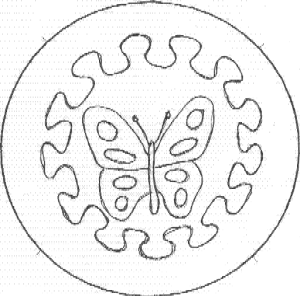 |
Azure, a butterfly Or marked sable within a bordure nebuly Or The submitter will accept any changes to the name, does not express a preference if changes must be made, does not express a preference for an authentic name, and will accept a holding name. The Barony's name was registered in March 1983. Other than a quote of RfS III.2.b.ii (Names of Orders and Awards), no documentation for this submission is provided. The submitter indicates that “this is the second level Arts and Sciences Award.” The prior version of this badge was returned in Kingdom in June 2003. The badge was blazoned as Azure, a butterfly Or marked sable and a bordure nebuly Or, and was returned because the butterfly “was colored in mostly black with yellow outlining and internal detailing”. As a result, this was found to be a violation of the rule of contrast. This redraw addresses that difficulty. | |
| 5. Aquaterra, Barony of, for Order of the Green Seahorse | Order name - New | |
|
The submitter will accept any changes to the name, does not express a preference if changes must be made, does not express a preference for an authentic name, and will accept a holding hame. The Barony's name was registered in March 1983. Other than a quote of RfS III.2.b.ii (Names of Orders and Awards), no documentation for this submission is provided. The submitter indicates that “this is for children's service award.” Query for Gorges Pursuivant: Is it the intent of the Barony that the badge blazoned as Or, a seahorse and a bordure nebuly vert (registered October 2003) be associated with this name if it is registered? | ||
| 6. Aquaterra, Barony of, for Order of the Golden Estoile | Order name — Resubmission to Laurel | |
|
The submitter will accept any changes to the name, does not express a preference if changes must be made, does not express a preference for an authentic name, and will accept a holding hame. The Barony's name was registered in March 1983. Other than a quote of RfS III.2.b.ii (Names of Orders and Awards), no documentation for this submission is provided. The submitter indicates that “this is the second level Service Award.” The prior submission, Order of the Starfish of Aquaterra, was returned in September 2002 LoAR for non-period style. Query for Gorges Pursuivant: Is it the intent of the barony that the badge blazoned as Azure, an estoile within a bordure nebuly Or, registered September 2002, be associated with this name if the name is registered? | ||
| 7. Aquaterra, Barony of, for Order of the Plate | Order name — New & Badge - resubmission | |
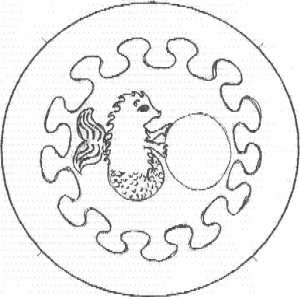 |
Gules, a sea urchin Or sustaining a plate within a bordure nebuly Or The submitter will accept any changes to the name, does not express a preference if changes must be made, does not express a preference for an authentic name, and will accept a holding name. The Barony's name was registered in March 1983. Other than a quote of RfS III.2.b.ii (Names of Orders and Awards), no documentation for this submission is provided. The submitter indicates that “this is the entry level Arts and Sciences Award.” The prior badge submission, blazoned as Gules, on a plate a cinquefoil sable charged on each petal with a goutte argent all within a bordure nebuly Or, was returned in June 2003 for violation of the rules concerning voiding and fimbriation, and for conflict with Anabella of Newmarch, Gules, on a plate a double rose proper, a bordure Or, with one CD for the change of type of bordure, but no differences between the tertiary charges. | |
| 8. Brynmor Raven | Lions Gate | Name & Device — New |
 |
Argent, a raven voided sable within a bordure vert on a chief vert three merlons argent The submitter will not accept major changes to his name, but cares most about language and culture if changes must be made. He deisres a male name, and wants a name authentic for 12th century Welsh. He will allow a holding name. His documentation is “World Book of Baby Names — Welsh Section.” | |
| 9. Ceoflaed Pyper | Porte de l'Eau | Badge — New |
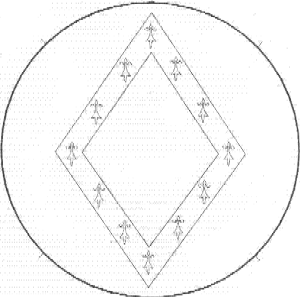 |
(Fieldless) a mascle counter-ermine The submitter's name was registered in the June 2004 LoAR. | |
| 10. Ciarán Alanson | Porte de l'Eau | Name & Device — New |
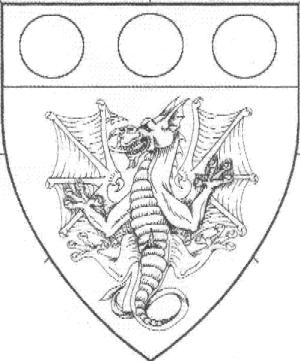 |
Or, a dragon displayed and on a chief gules three bezants. The submitter will not accept major changes to his name. If changes are required, he is more interested in the meaning, which he gives as “Ciaran, son of Alan.” He wants a male name, is not interested in authenticity, and will allow creation of a holding name. Ciarán is documented in Ó Corráin & Maguire, Irish Names, sub Ciarán, where four saints of this name are listed. The note indicates “Ciarán never became common as a secular name in the early period.” In addition, the submitter cites a St Gabriel website, but does not provide a copy of this documentation: http://www.s-gabriel.org/names/mari/ AnnalsIndex/Masculine/Ciaran.shtml. Alanson is documented from Reaney & Wilson, 3rd, sub Allanson, where the submitted spelling is dated to 1395 in the name John Alanson. | |
| 11. Eadric de Lonestone | Dragon's Laire | Name & Device — New |
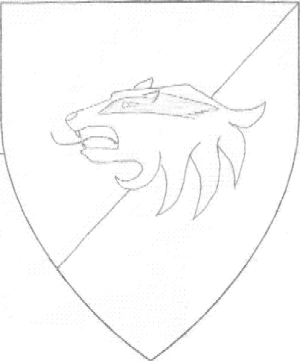 |
Per bend sinister azure and sable a badgers head erased The badger's head is argent marked sable. The submitter will not accept major changes to his name. He does not express a preference if changes are required. He wants a male name, and is interested in a name authentic for the time period, language and culture of “Late 11th Early 12th Century Anglo Norman.”
Eadric is documented from Talan Gwynek, “Men's Given Names from Early
13th Century England”, http://www.s-gabriel.org/talan/eng13/eng13m.html,
sub Edric, where it notes “From OE Eadric.” Lonestone is a constructed place which the submitter indicates is derived from his place of residence, Lone Rock | |
| 12. Elric Strangulf | Mountain Edge | Badge — New |
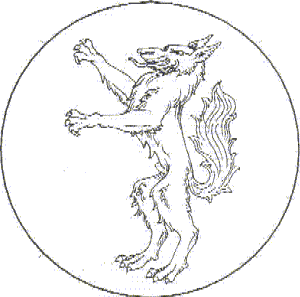 |
(Fieldless) a wolf salient Or. The submitter's name was registered in the January 1997 LoAR. | |
| 13. Elric Strangulf, for Hous of Graneshavene | Mountain Edge | Household Name — New |
|
The submitter's name was registered in the January 1997 LoAR. The submitter will accept any changes necessary to register this name. If changes are required, he is more interested in the sound of the name. Please note the preference indicated in the documentation. He expresses no preference as to gender, is interested in a name authentic for the time period, language and culture of 13th to 15th century English. He will allow creation of a holding name. For documentation, he notes: “The spelling <Hous> is found in the Oxford English Dictionary, http://www.oed.com/ (subscription required), s.n. <house> dated to 1290, c. 1340, 1362, 1382, and 1398, among others. Graneshavene is a constructed thirteenth century English placename based on a hypothetical Old Norse <Granes hafn> meaning “gray headland harbour”. Edkwall (4th ed) sub <Grayrigg>, p. 203, lists Grarigg c. 1165; the placename is glossed as “gray ridge”, and is derived from the Old Scandinavian <grá(r)>. Eckwall, s.n. <Crossens> p. 132, lists <Crossenes> in 1250 and 1323; the name is derived from the Old Norse <krossa-nes>, meaning “headland with crosses.” Eckwall, sn <Whitehaven>, p. 514, lists various spellings including <Hwithothehavene> in 1202; it is derived from Old Norse <Hvita-ho,fu{dh}>. If the name must be changed, our priority is the element <havene>.” | ||
| 14. Rhys ap Dafydd | Cragmere | Device — Resubmission to Kingdom |
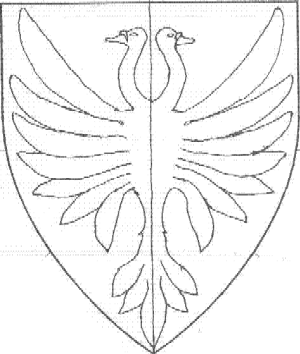 |
Per pale azure and Or, a double headed swan displayed counterchanged The submitter's name was registered in the November 2000 LoAR. The prior submission, Chevronnelly per pale azure and Or, a double headed swan displayed counterchanged, was returned in July 2000 in kingdom for excessive use of counterchanging, noting period use would have had the field or the charge chevronnelly, but not both. This redesign addressed that difficulty. | |
| 15. Sayna de Lincolne | Porte de l'Eau | Device — New |
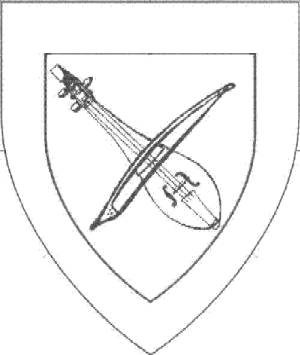 |
Argent, a rebec and bow in saltire within a bordure gules The submitter's name was registered in the May 2004 LoAR. | |
| 16. Stein Vikingsson | Montengarde | Device — Resubmission to Laurel |
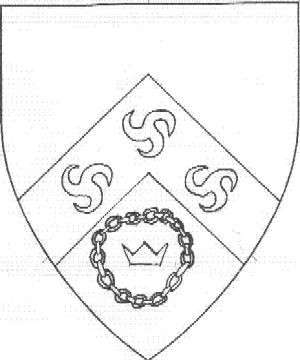 |
Azure, on a chevron Or three triskeles azure, in base a coronet within an annulet of chain Or. The submitter's name was registered in the March 2004 LoAR. His prior submission, Azure, on a chevron Or three triskeles azure and in base a coronet within an annulet of chain Or, was returned in the May 2005 LoAR for lack of documentation that the style of coronet used in that submission was a period style of coronet. This resubmission corrects that deficiency by using a “traditional” SCA style coronet. The submitter was knighted in February 2003, and received his viscounty in February 2004. | |
| 17. Susanne Von Hemmi | Myrtleholt | Name & Device — New |
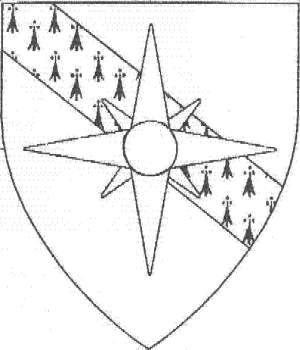 |
Per bend Gules and Vert, a bend ermine, overall a compass star Argent charge in its Center a roundel sable The submitters will accept any changes. If changes are required, she prefers the meaning be maintained, which she states is “From Hemedal (Late Baron, my boyfriend.)” She wants a female name, and a name authentic for the time period 1060-1200 German. She will allow a holding name. Susanne is documented from Hanks & Hodges, A Dictionary of First Names, sub Susanna, where it indicates the German form of this name is Susanne, and that this name was popular in the Middle Ages. The “von Hemmi” is documented with the following statement: “The ‘von Hemmi’ is in reference to my late love, Baron Matthew Hemidal.” In the device, the tincture of the compass star is large points white, small points sable, central circle sable | |
| 18. Timur-as Qazaq, from Bébhínn Morgan | Three Mountains | Name — Change - resubmission |
|
The submitter will not accept major changes to her name. If changes are required, she is interested in the sound or language/culture. She does not care about the gender of the name, but is interested in a name authentic for the time period, language and culture of pre-Islamic Central Asia. She will allow a holding name. Her prior name submission, Tomyris Al Altani was returned at the May 2004 An Tir Lions Blood meeting, for use of a legendary name as a given name. This reconstruction addresses that issue.
Timur is given as a variant spelling of the common Central Asian/Turkic name
element meaning “iron.” This is supported in part by http://www.silk-road.com/artl.timur.shtml
where Tamerlane (1336-1405) where this name is the European derived name given to the
Persian Timur-i lang, meaning “Temur the lame”. -as is found in Menchen-Helfen, The World of the Huns: Studies in Their History and Culture, (1973), pp. 408-409, where the author derives the name Eskam, a daughter of Attila, from as and qam, and states as means friend, companion. It is worth noting that in both the website noted above, and in this extract, there are several examples of names featuring a hyphen: Timur-i, Ilig-är and qut-elci. Qazaq is found in St. Gabriel Report 2123, http://www.s-gabriel.org/2123, where it indicates that “the Romanian word <cazac>, “Cossack”, appears to be derived from South Turkic <qazaq>, “adventurer.”” And notes that Cossack appears in English as early as 1598, suggesting this name appears in Romanian even earlier, and presumably in Turkic yet earlier. If this name change is registered, she desires to make Bébhínn Morgan an alternate name. This name was registered in May 1993. | ||
| 19. Timur-as Qazaq, from Bébhínn Morgan to Bébhínn Inghean Áeda | Three Mountains | Name — Change - new |
|
In this submission, Timur-as is changing the name Bébhínn Morgan, which she retained as an alternate name, to Bébhínn Inghean Áeda. The submitter will not permit major changes to her name. If changes are required she is more interested in the language or culture. She desires a female name. She is interested in a name authentic for pre-1000 Ireland time period, language and culture, and will permit creation of a holding name. Bébhínn is currently registered to this submitter. Inghean is found in http://medievalscotland.org/scotnames/quickgaelicbynames/index.shtml, which indicates that “the standard way to form a name using a simple patronymic byname for women is: <single given name> inghean <father's given name> (in genitive case & always lenited unless starting with D,T,L,N,R, or a vowel).> Áeda is found in Mari Elspeth nic Bryan, “Dated Names Found in Ó Corráin & Maguire's Irish Names”, http://www.s-gabriel.org/names/mari/ocm/OCM-PatMacByn.html, where the article indicates that in Ó Corráin & Maguire, sub Bé Fáil and sub Fingin, appear two dated examples of patronymic bynames composed of Áeda: Donnchad mac Áeda and Fíngin mac Áeda, dated to c.801 and 619 respectively. If this name change is registered, Timur-as wishes to retain Bébhínn Morgan as an alternate name. (Query: Then should not this name change be forwarded merely as a new alternate name registration?) | ||
| 20. Wealdsmere, Barony of | Badge — New | |
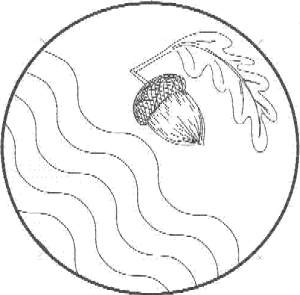 |
Per bend wavy Or and bendy wavy azure and argent, in chief an oak leave conjoined at the stem with an acorn all bendwise proper. The branch name was registered in the April 1982 LoAR. This badge is to be associated with the sergeants of Wealdsmere. | |
| 21. Wealdsmere, Barony of | Badge — New | |
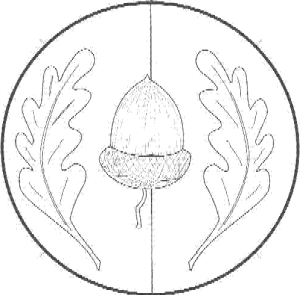 |
Per pale Or and vert, in fess and acorn inverted proper between two oak leaves counterchanged. The branch name was registered in the April 1982 LoAR. This badge is to be a populace badge. | |
In service,

Richenda du Jardin |
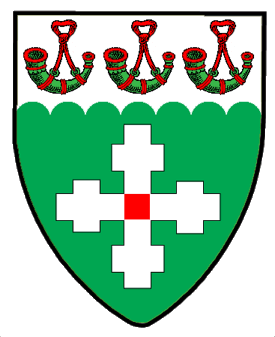
David of Moffat |

Uilliam mac Ailéne mhic Seamuis |